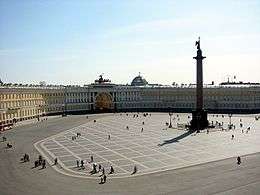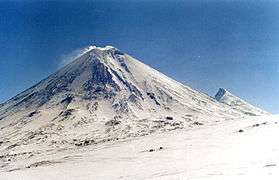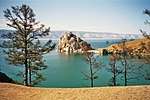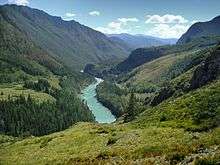Bolghar
| UNESCO World Heritage site | |
|---|---|
|
| |
| Official name | Bolgar Historical and Archaeological Complex |
| Location | Volga Federal District, Russia |
| Criteria | Cultural: (ii), (vi) |
| Reference | 981rev |
| Inscription | 2014 (38th Session) |
| Area | 424 ha (1.64 sq mi) |
| Buffer zone | 12,101 ha (46.72 sq mi) |
| Coordinates | 54°58′44″N 49°03′23″E / 54.97889°N 49.05639°ECoordinates: 54°58′44″N 49°03′23″E / 54.97889°N 49.05639°E |
 Location of Bolghar in Russia | |
Bolghar (Tatar: Болгар, Chuvash: Пăлхар) was intermittently capital of Volga Bulgaria from the 8th to the 15th centuries, along with Bilyar and Nur-Suvar. It was situated on the bank of the Volga River, about 30 km downstream from its confluence with the Kama River and some 130 km from modern Kazan in what is now Spassky District. West of it lies a small modern town, since 1991 known as Bolgar. The UNESCO World Heritage Committee declared ancient Bolghar hill fort as a World Heritage Site in 2014.
History
The city is supposed to have been the capital of Volga Bulgaria from as early as the 8th century. Regular Russian incursions along the Volga, and internecine fights forced the Volga Bulgar kings to intermittently move their capital to Bilyar. After a destruction of Bilyar during the Mongol invasion, the older capital became a centre of a separate province (or duchy) within the Golden Horde. During the period of Mongol domination Bolgar acquired immense wealth, many imposing buildings, and grew tenfold in size.
The Tokhtamysh–Timur war saw a marked decline in its fortunes. It was sacked by Bulaq-Temir in 1361, endangered by Timur, looted by Russian pirates (ushkuiniki), and destroyed in 1431 by Vasily the Blind of Muscovy. As a Muslim religious center Bolgar persevered until the mid-16th century when the Khanate of Kazan was conquered by the Russian Czar Ivan IV and incorporated into the Russian state.
During the Tsarist rule the site of the ancient town was settled by Russian commoners. Czar Peter the Great issued a special ukase to preserve the surviving ruins, which was probably a first Russian law aimed at preserving historical heritage.
Little pilgrimage
During the Soviet period, Bolgar was a center of a local Islamic movement known as The Little Hajj: Muslims from Tatarstan and other parts of the Soviet Union could not participate in the hajj to Mecca, so they travelled instead to Bolgar.
Monuments and temples
- Eastern mausoleum
- Khans' mausoleum
- Northern mausoleum
- Black Chamber
- White Chamber
- Big manara
- Small manara
 New Bolghar cathedral White Mosque
New Bolghar cathedral White Mosque
Importance
The Tatars refer to the medieval capital of Volga Bolgaria as Shahri Bolghar (Tatar: Шәһри Болгар), that is, "the City of Bolghar". The town is part of their cultural heritage, because Volga Bolgaria is viewed by many Tatars as a predecessor state of the Khanate of Kazan, which in turn has cultural links to today's Russian republic of Tatarstan.
Today, the capital of Tatarstan is Kazan, but many Tatars consider Bolghar to be their ancient and religious capital and to allow a glimpse of Muslim Bulgar life before the Mongol invasion of Volga Bulgaria.
References
- Edward Tracy Turnerelli, Kazan, the Ancient Capital of the Tartar Khans, 1854, pp 196-261
External links






